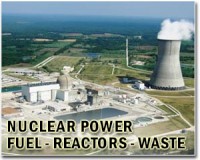 |
Tokyo (AFP) March 12, 2011 Radiation leaked from a quake-hit Japanese nuclear plant Saturday, but the government moved to calm fears of meltdown and said a huge explosion had not ruptured the container surrounding the reactor. An evacuation order for tens of thousands of residents was expanded to 20 kilometres (12 miles) around the Fukushima plant, where authorities scrambled to control rising temperatures and pressure inside several reactors. The fear was that evaporating cooling liquid would expose the fuel rods to air, triggering a nuclear meltdown and major radiation leak. Japan had on Friday declared an atomic emergency amid growing international concern over its reactors after an 8.9 magnitude earthquake, the biggest in Japan's history, unleashed tsunamis that destroyed everything in their path. The US Air Force, which has many bases in Japan, on Friday delivered coolant to a nuclear plant there, US Secretary of State Hillary Clinton said that day, without specifying which plant. The operator Tokyo Electric Power (Tepco) pumped water into the Fukushima No. 1 plant and released steam to depressurise the hut containers, an action that experts say will release a certain amount of radioactive vapour. Tepco said that, at its highest level, the hourly radiation inside the plant reached 1,015 micro sievert before the blast -- equivalent to the permissible exposure for people over one year. In the afternoon a huge explosion ripped through the plant, and a massive plume of white smoke billowed into the sky, raising fears the steel reactor had been destroyed. But Tepco later said it was the structure encasing the reactor that had collapsed, saying that this took place at the time of an earthquake aftershock, and that the steel reactor inside it was not ruptured. It said that, after the explosion, the radiation levels had dropped sharply, to about 64 micro sievert by the evening. Top government spokesman Yukio Edano said containment activities would now focus on "dousing the container with sea water". Premier Naoto Kan, speaking at the same press conference, urged residents to stay calm and vowed the government would "do our best not to have even a single person suffer from health problems". TV channels earlier warned nearby residents going outside to avoid exposing their skin and to cover their faces with masks or wet towels. Tepco said four of its workers had been injured in the blast at the plant 250 km northeast of Tokyo, but that the injuries were not life-threatening. Japan records 20 percent of the world's major earthquakes. It generates about 30 percent of its power from about 50 nuclear plants.
Share This Article With Planet Earth
Related Links Nuclear Power News - Nuclear Science, Nuclear Technology Powering The World in the 21st Century at Energy-Daily.com
 Japan nuclear mishap among worst ever: US expert
Japan nuclear mishap among worst ever: US expertWashington (AFP) March 12, 2011 A US nuclear expert said Saturday that the accident at a Japanese nuclear reactor was one of the three worst in history, and could become a "complete disaster" if it goes to a full meltdown. "This is going to go down in history as one of the three greatest nuclear incidents if it stops now," Joseph Cirincione, the head of the Ploughshares Fund, said in an interview on CNN. "If it continu ... read more |
|
| The content herein, unless otherwise known to be public domain, are Copyright 1995-2010 - SpaceDaily. AFP and UPI Wire Stories are copyright Agence France-Presse and United Press International. ESA Portal Reports are copyright European Space Agency. All NASA sourced material is public domain. Additional copyrights may apply in whole or part to other bona fide parties. Advertising does not imply endorsement,agreement or approval of any opinions, statements or information provided by SpaceDaily on any Web page published or hosted by SpaceDaily. Privacy Statement |